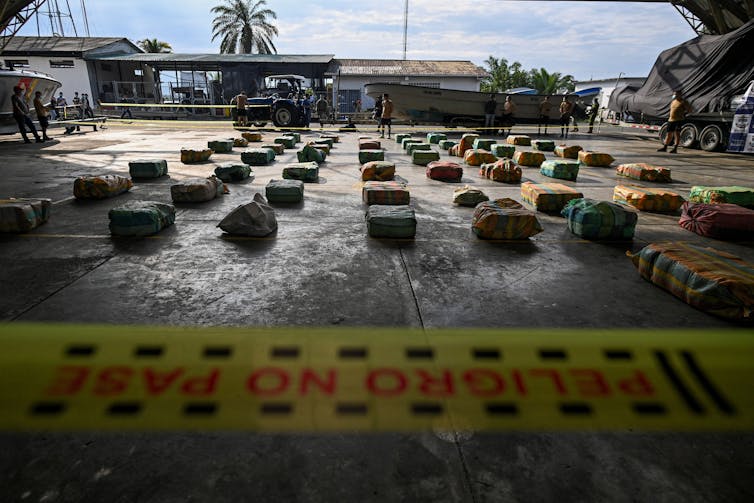Shauna N Gillooly, University of California, Irvine
Chaotic and deadly protests have for weeks rocked the Colombian port city of Buenaventura. In mid-May some demonstrators stormed the airport, and riot police responded with force, killing three.
Buenaventura’s demonstrations are a part of the massive, violent national wave of protests over increasing poverty and incessant violence in Colombia. But they actually began well before Colombia’s broader upheaval.
Since early 2021, people in this majority-Black coastal city have been rising up peacefully but insistently against rampant drug trafficking, political violence and cartel infiltration.
Organized crime and illicit economies are both national problems in Colombia. But in Buenaventura, a history of state neglect has allowed both to flourish unchecked, according to my academic research in the city.
For many Colombian and international observers, the government’s apparent lack of interest in saving Buenaventura has a clear source: structural racism resulting from state policies that have long marginalized Black Colombians.
Abandoned city
Black people, or Afro-Colombians, make up approximately 10% of Colombia’s 50 million people and 85% of Buenaventura’s population.
Many residents originally came to Buenaventura – located approximately 300 miles from Colombia’s Andean capital, Bogota – as war refugees from different parts of Colombia’s Pacific region to escape armed conflict.
Colombia is home to a half-century long battle among guerrillas, the government and paramilitary groups. The war technically ended with a 2016 peace accord, but Colombia’s ever-changing and complex armed conflict continues to kill and displace scores each year. Most violent crimes in the country go unsolved.
Activists and human rights groups say Buenaventura’s dismal and dangerous living conditions reflect long-standing disparities between Black and white Colombians. For example, approximately 41% of Afro-Colombians live in poverty, compared with 27% of white Colombians.
All Buenaventura is in desperate need of investment to upgrade its dilapidated or nonexistent infrastructure. Many neighborhoods lack drinkable water, trash pickup and functioning sewers. Sewage runs underneath houses near the port and flows untreated into the Pacific Ocean.

Medical care is also poor in Buenaventura. Local clinics often do not have the supplies or capacity to treat many patients, so sick Buenaventura residents are referred to hospitals in Cali, three hours away. Last June, Buenaventura had Colombia’s highest COVID-19 mortality rate.
A chronic 75% unemployment rate and 64% poverty rate – twice the national average – make local youth easy recruits for armed groups. The lack of state presence also allows these groups to threaten and attack locals without accountability. Many residents do not even report such incidents to police for fear of retaliation.
Although the Colombian national government normally has little presence in Buenaventura, it flexed its muscle when protests broke out. In February, amid the outburst of cartel violence, marines were sent to patrol city streets. And in May, when some protests turned to riots, security forces quelled the uprising with deadly violence.
Cries of “Black Lives Matter” – or “las vidas negras importan” – became a theme in the city’s protests, as residents in this oppressed city connect their struggles with those of Black people in the U.S. and worldwide.
Cartel violence
Despite these troubles, Buenaventura is home to Colombia’s most vital port. Over 50% of all Colombian imports and exports move through the city.

That includes legal goods such as coffee and mined minerals as well as illegal products such as marijuana and cocaine, which is processed in hidden laboratories throughout the country. Cocaine is shipped from Buenaventura to partner cartels in Central America and on to the U.S. or directly to Europe – the world’s biggest cocaine markets.
Each kilo of cocaine that makes it to Europe earns approximately US$30,000. Controlling Buenaventura and connecting waterways is a profitable enterprise for Colombia’s many criminal operations.
For years, a local narco-trafficking group called La Local held a comfortable monopoly on illegal imports and exports, allowing for relative peace. But in late 2020, the group split into factions.
The resulting turf war led to at least 30 murders and 40 disappearances by February 2021. Another 6,000 people in Buenaventura were forced to flee their homes to escape crossfire. Some fled besieged portside neighborhoods after death threats.
“There’s collective panic, a generalized sense of insecurity where we can’t feel at ease even in our own neighborhoods or houses or in public spaces,” local activist Danelly Estupiñán told The Guardian newspaper in February. That newspaper has called Buenaventura “Colombia’s Capital of Horror.”

Desperate to stop spiking violence, which Estupiñán called a “humanitarian crisis,” residents in this city of 450,000 staged large-scale protests early this year.
At one point in February, they formed a 13-mile human “chain for peace.”
Buenaventura’s fight for government investment, inclusion in national policymaking and better social welfare programs has had limited success so far.
But locals say something has to change – and they won’t stop marching until it does.
[Get the best of The Conversation, every weekend. Sign up for our weekly newsletter.]
Shauna N Gillooly, PhD Candidate, Political Science, University of California, Irvine
This article is republished from The Conversation under a Creative Commons license. Read the original article.






